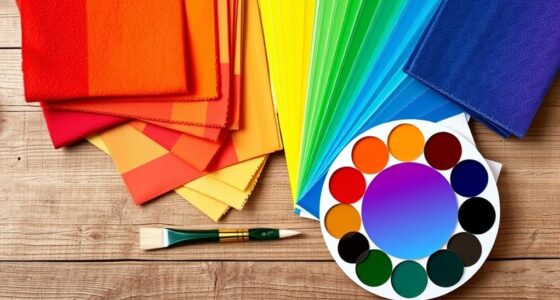To avoid tarnish when mixing metallic leaf with acrylics, choose high-quality, durable metals and prepare your surface properly by cleaning and smoothing it. Apply thin, even coats of metallic leaf and use compatible primers and acrylic mediums to guarantee good adhesion. Seal your work with a clear, protective varnish suitable for metals to shield it from moisture and oils. Handle with care, store in a dry spot, and consider ongoing maintenance—these tips will help keep your piece looking vibrant for years to come.
Key Takeaways
- Use high-quality, tarnish-resistant metallic leaf for better durability and shine preservation.
- Properly clean and prepare surfaces to ensure smooth adhesion and reduce tarnishing risks.
- Apply thin, even coats of metallic leaf and compatible sealants to protect against moisture and tarnish.
- Select UV-resistant, non-yellowing acrylic mediums compatible with metallic leaf for long-lasting results.
- Handle with gloves, store in dry, dust-free environments, and regularly inspect to maintain metallic leaf’s brilliance.
Choosing the Right Metallic Leaf for Long-Lasting Shine

When selecting metallic leaf for your project, it’s essential to choose high-quality options that will maintain their shine over time. The right metallic leaf selection directly impacts the durability and appearance of your artwork. Look for authentic gold, silver, or other high-grade metals, as these offer a long-lasting shine and resist tarnishing. Cheaper alternatives may seem tempting but often fade or tarnish quickly, diminishing your finished piece’s vibrancy. Consider the purity and thickness of the leaf—thicker, higher-quality sheets generally last longer and provide better coverage. Additionally, check for a smooth, even surface free of flaws. Investing in premium metallic leaf guarantees your project retains its brilliance and elegance over time, making it a worthwhile choice for artists seeking lasting beauty. Proper storage and metallic leaf maintenance also play a crucial role in preserving its appearance over the years, especially considering the prolonged exposure that can lead to tarnishing if not properly cared for.
Preparing Your Surface for Optimal Adhesion and Durability
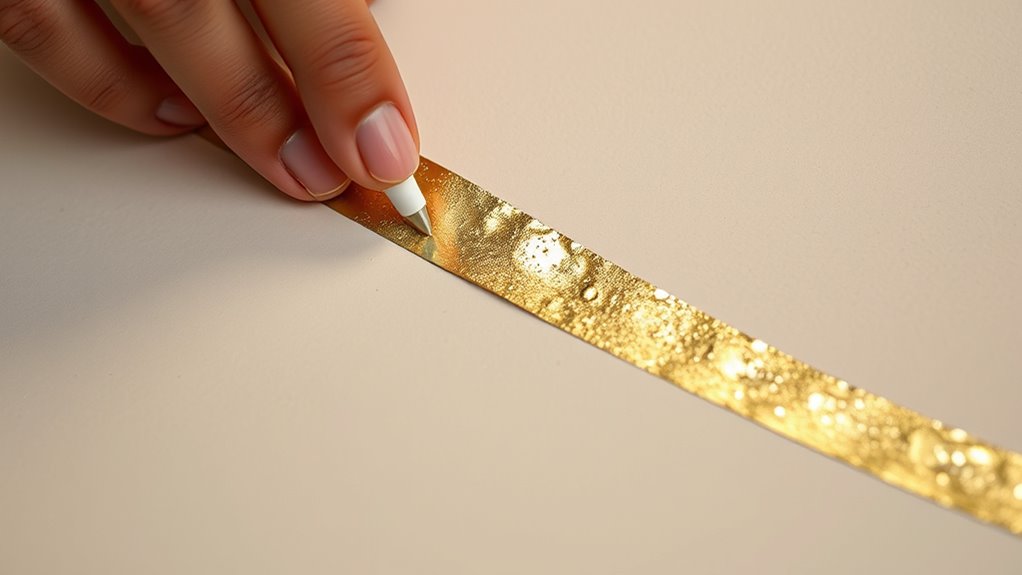
To guarantee your metallic leaf sticks well and lasts, start by thoroughly cleaning your surface to remove dust and oils. Next, apply a suitable primer to improve adhesion and prevent peeling over time. Using a proper surface preparation technique can further enhance the bond between the metallic leaf and your surface. Additionally, selecting a high-quality adhesive designed specifically for metallic leaf can provide extra security and longevity. Carefully following manufacturer instructions for application techniques ensures the best results. For optimal durability, consider incorporating automation’s role in business intelligence, which emphasizes precise and consistent application methods. Finally, choose a reliable sealant to protect your work and enhance its durability. Using a vetted product designed specifically for metallic leaf can also help prevent tarnish and maintain its shine over time.
Surface Cleaning Techniques
Before applying metallic leaf with acrylics, thoroughly cleaning the surface is vital to guarantee ideal adhesion and durability. Start by using cleaning brushes to remove loose dirt, dust, and debris. Pay special attention to corners and crevices where dust tends to settle. Dust removal is essential because any particles left on the surface can cause uneven adhesion or bubbling under the leaf. Wipe the surface with a soft, lint-free cloth to ensure all dust is eliminated. If needed, lightly dampen the cloth with water or a gentle cleaner, but avoid excess moisture. A clean, dust-free surface provides a smooth foundation for the metallic leaf, preventing tarnish or peeling later on and ensuring your work lasts beautifully.
Priming for Adhesion
Proper priming is essential to guarantee the metallic leaf adheres smoothly and stays durable over time. A good primer creates a strong bond, ensuring your metallic leaf textures remain intact during acrylic blending techniques. To get the best results, consider these tips:
- Use a primer compatible with both metal leaf and acrylics
- Apply a thin, even coat to prevent uneven textures
- Sand lightly between coats for smoother surfaces
- Choose a primer designed for porous or non-porous surfaces
- Allow sufficient drying time before applying metallic leaf or paint
Choosing Suitable Sealants
Selecting the right sealant guarantees your metallic leaf adheres firmly and lasts over time. A suitable sealant enhances the metallic finish and provides essential surface protection against tarnish and wear. Consider whether you want a gloss, matte, or satin finish, as this affects the final look. Choose a sealant compatible with acrylics and metallic leaf to ensure proper adhesion and durability. Here’s a quick guide:
| Sealant Type | Best Use |
|---|---|
| Acrylic Varnish | Clear, protective surface with sheen |
| Polyurethane | Heavy-duty surface protection |
| Wax or Satin Finish | Soft sheen, easy to reapply |
Pick wisely to maintain your artwork’s vibrance and longevity, avoiding tarnish and damage.
Proper Application Techniques to Minimize Tarnish Risks
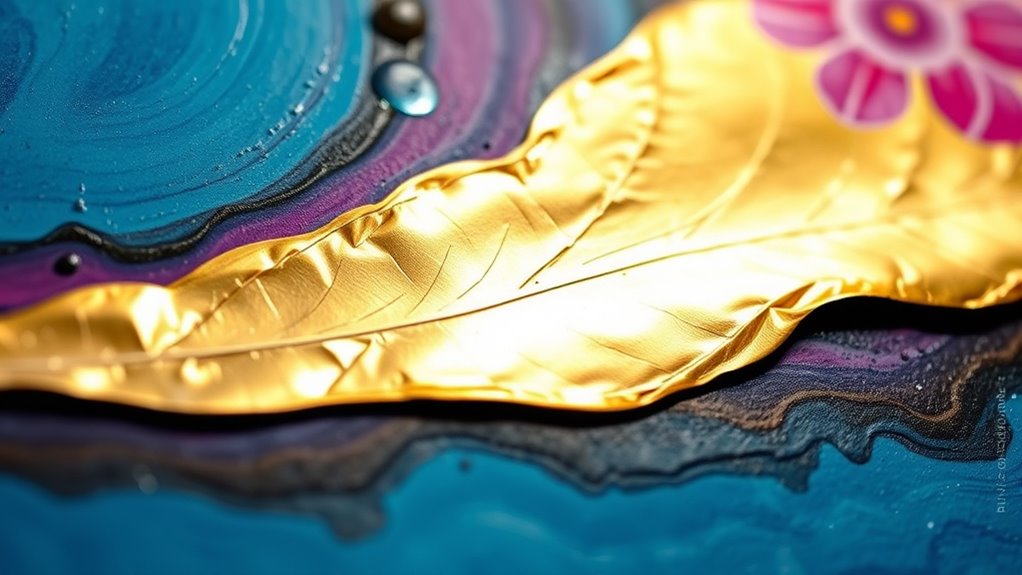
To prevent tarnishing, you should always seal metallic layers after application. Using the right adhesives guarantees the leaf stays in place without exposing it to moisture, which can cause discoloration. Applying a protective coat over the finished piece creates an extra barrier, keeping tarnish at bay and extending its lifespan. Staying informed about proper application techniques can further help in preventing tarnish. Proper surface preparation and coating methods are also essential to ensure a durable and tarnish-resistant finish. Additionally, understanding textile art techniques and how to maintain them can help ensure the longevity of your artwork, reducing the risk of issues that could indirectly affect your creative process.
Seal Metallic Layers
Applying a high-quality sealant is essential for protecting metallic leaf layers from tarnishing, especially when working with acrylics. Proper sealing preserves the shine and prevents oxidation that can occur during acrylic layering. To achieve the best results, choose a sealant compatible with metallic leaf techniques and acrylic paints. Ensure the surface is clean and dry before application. Use thin, even coats and avoid over-saturating the leaf, which can cause discoloration or peeling. Applying sealant in a dust-free environment helps prevent imperfections. Remember, careful sealing minimizes tarnish risks and extends the longevity of your artwork.
- Use a clear, matte or gloss sealer suitable for metallic leaf
- Apply with a soft brush or spray for even coverage
- Allow sufficient drying time between coats
- Test sealant on a small area first
- Reapply as needed during acrylic layering
Use Proper Adhesives
Using proper adhesives is essential when applying metallic leaf to prevent tarnish and guarantee lasting adhesion. Selecting the right adhesive types ensures a strong bond and reduces the risk of peeling or tarnishing over time. For delicate metallic leaf, opt for adhesive options with high bond strength that are specifically formulated for metallic surfaces and acrylics. Avoid using adhesives that are too weak or incompatible, as they can cause gaps, trapping moisture that accelerates tarnish. Apply the adhesive evenly and sparingly, following the manufacturer’s instructions, to ensure a smooth, secure bond. Proper application techniques not only improve durability but also help maintain the metallic leaf’s luster and prevent tarnish caused by improper adhesion or moisture infiltration.
Apply Protective Coats
Have you considered how proper application techniques for protective coats can substantially reduce the risk of tarnish on metallic leaf? Using the right methods guarantees your metallic paint and protective varnish are effective and long-lasting. To minimize tarnishing, apply thin, even coats and avoid over-brushing. Use a clean, soft brush or spray for smooth coverage. Allow each layer to dry completely before adding the next. Seal the metallic leaf with a high-quality protective varnish designed for metals. Always test on a small area first. Proper application prevents moisture and air from reaching the metallic layer, reducing tarnish risk.
- Use a fine brush or spray for even coverage
- Apply thin, multiple coats rather than one thick layer
- Ensure complete drying between coats
- Choose a varnish compatible with metallic leaf
- Work in a dust-free environment
The Importance of a Protective Sealant for Metallic Leaf Artwork
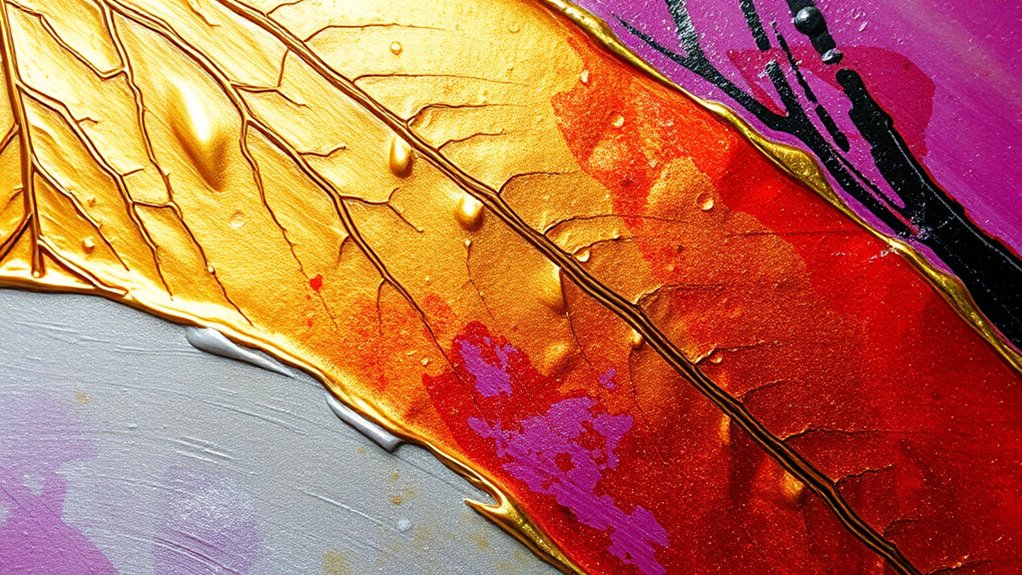
Because metallic leaf is delicate and prone to tarnishing or damage, a protective sealant is essential to maintain its brilliance and overall durability. Applying a sealant helps shield the leaf from environmental factors like moisture, oils, and handling, which can compromise its appearance over time. When choosing a sealant, make sure it offers good metallic leaf durability without reacting negatively with your acrylic layers. Compatibility with acrylic mediums is critical; an incompatible sealant could cause discoloration or deterioration. A clear, flexible sealant formulated for use with acrylics will provide a protective barrier while preserving the metallic leaf’s reflective qualities. Proper sealing not only extends the lifespan of your artwork but also guarantees the vibrant, eye-catching finish you desire remains intact for years to come. Additionally, understanding the properties of different sealants can help you select the most suitable product for your specific metallic leaf project. Considering the environmental conditions in which your artwork will be displayed is also crucial, as factors like humidity and temperature fluctuations can affect the longevity of the sealant. Selecting the right sealant also involves evaluating its breathability, which helps prevent moisture buildup that could lead to deterioration.
Selecting Compatible Acrylic Mediums to Enhance Longevity
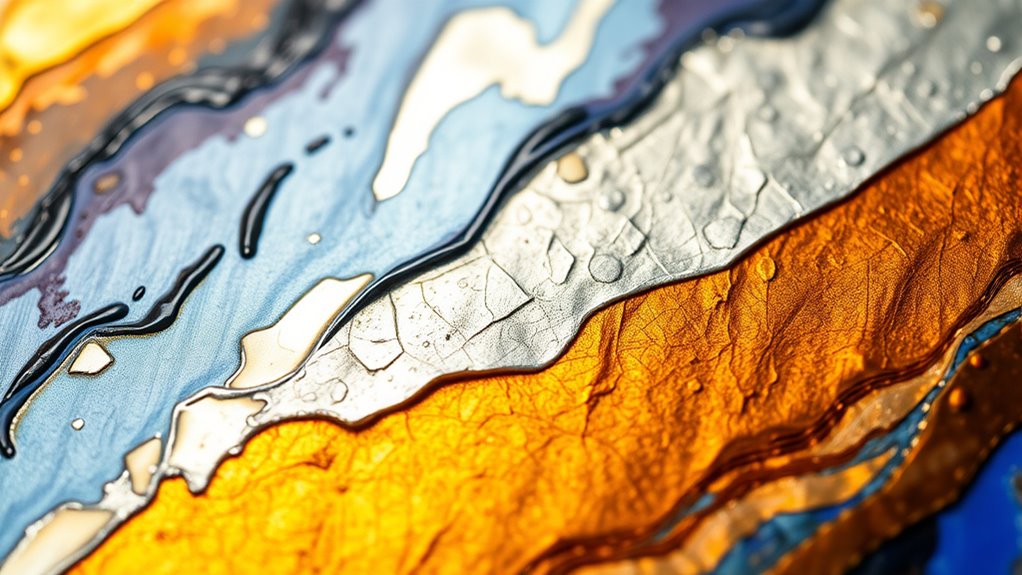
Choosing the right acrylic mediums is essential for ensuring your metallic leaf artwork remains vibrant and durable over time. Proper selection enhances longevity by preventing tarnish and maintaining the metallic leaf’s brilliance. To achieve the best results, focus on acrylic medium compatibility with metallic leaf, ensuring they don’t react negatively.
Consider these key points:
- Use mediums specifically formulated for mixed media projects
- Opt for non-yellowing, UV-resistant acrylics
- Select compatible acrylic mediums that won’t cause tarnish
- Avoid overly thick or greasy mediums that can dull the leaf
- Test small samples to confirm metallic leaf selection harmonizes with your chosen acrylics
- Be aware of affiliate disclosures and ensure your materials are compliant with transparency standards to maintain trust and integrity in your artwork.
Additionally, choosing mediums that are designed for mixed media can help improve adhesion and prevent future deterioration.
Tips for Handling and Storing Your Metallic-Accented Pieces
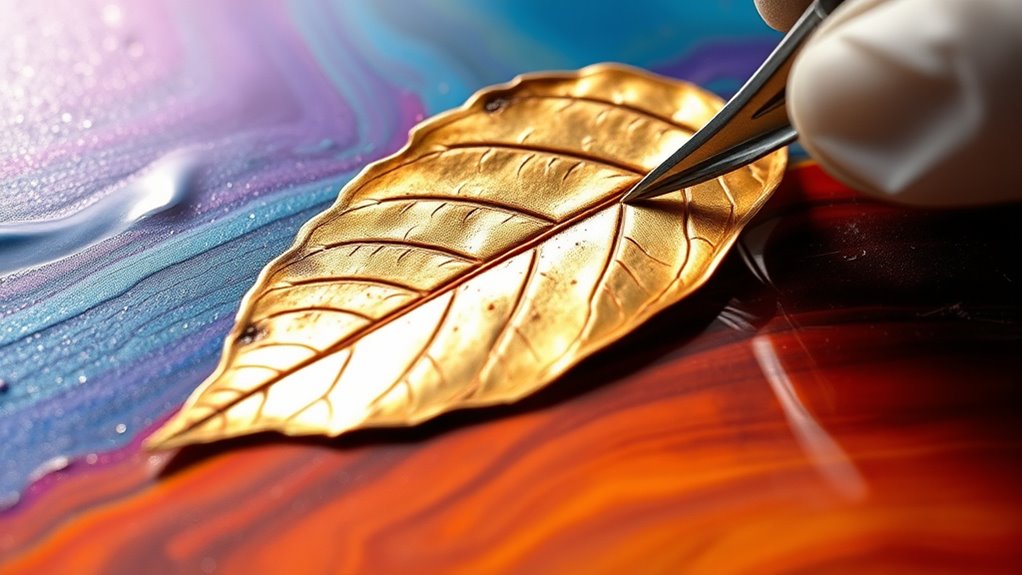
Handling and storing your metallic-accented pieces carefully is essential to maintain their shine and prevent damage. Use proper handling techniques, such as wearing gloves to avoid fingerprints and smudges that can dull the metallic finish. When storing, keep your artwork in a clean, dry environment away from direct sunlight, which can cause tarnishing or fading. Use soft, padded storage containers or wrap pieces in acid-free tissue paper to prevent scratches and abrasions. Avoid stacking metallic pieces directly on top of each other; instead, store them separately or with protective layers. Regularly inspect your artwork for signs of tarnish or deterioration, and handle with gentle care to preserve their vibrant, reflective qualities over time. Developing a methodical testing process can help identify potential issues early and maintain your pieces’ condition. Additionally, understanding the history of pinball machines can inspire unique design elements and appreciation for craftsmanship in your metallic work. Proper storage of metals and understanding their specific care needs will further prolong the brilliance of your metallic accents.
Avoiding Common Mistakes That Lead to Tarnishing
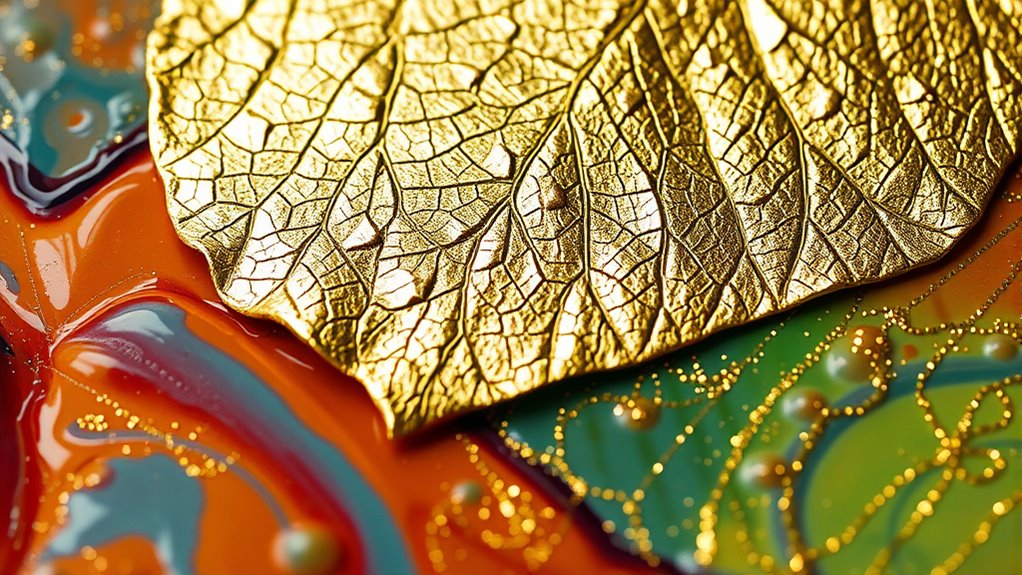
Avoiding common mistakes that lead to tarnishing starts with understanding how environmental factors can affect your metallic leaf. Metal leaf oxidation occurs when exposed to moisture, pollution, or acidic environments, accelerating tarnish. Improper handling or storage can also cause damage. Additionally, poor acrylic interaction may trap moisture or chemicals against the leaf, speeding up tarnishing. To prevent this, avoid these mistakes:
Environmental exposure and improper handling accelerate metallic leaf tarnish. Prevent damage by controlling environment and application techniques.
- Applying acrylic varnish too thick or unevenly
- Exposing artwork to high humidity or direct sunlight
- Using low-quality or incompatible acrylic mediums
- Touching metallic leaf with bare hands
- Storing pieces in damp or unsealed environments
Being mindful of these factors helps preserve the shine and prevents tarnish, ensuring your artwork remains vibrant over time.
Maintaining and Preserving Your Artwork Over Time
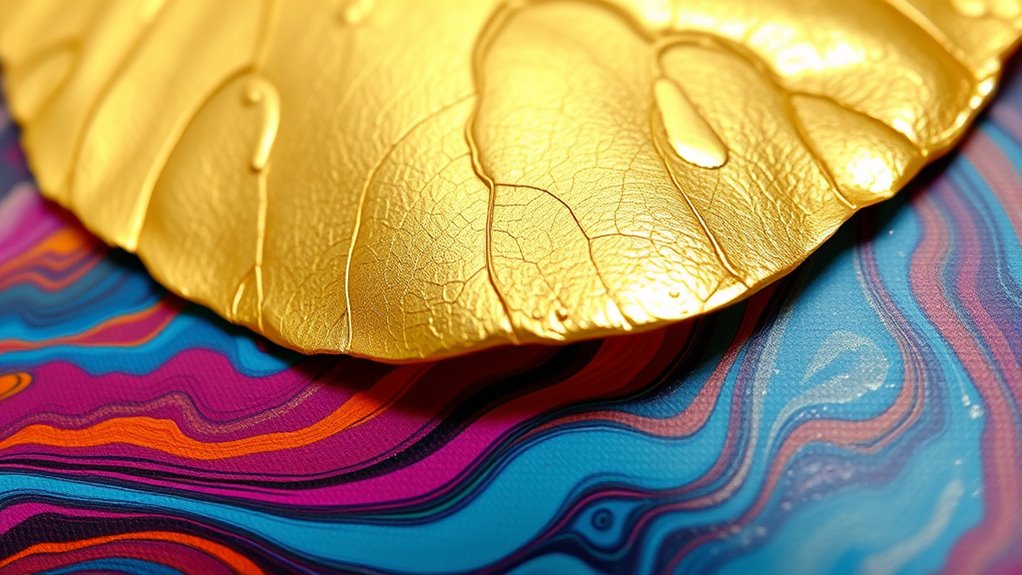
Once you’ve applied your metallic leaf and acrylic finishes correctly, the focus shifts to maintaining and preserving your artwork so it stays vibrant over time. To do this, understand that natural patina development and the aging process can add character but may also cause discoloration or dullness. Keep your piece out of direct sunlight and avoid excessive moisture, which can accelerate deterioration. Regularly dust it with a soft, dry cloth to prevent dirt buildup. If you notice signs of tarnish or dulling, gentle cleaning with appropriate products can help restore its luster. Proper handling and environmental control are key to prolonging your artwork’s life, ensuring the metallic leaf remains striking and the acrylic finishes stay clear for years to come.
Troubleshooting Tarnish and Discoloration Issues

Tarnish and discoloration can occur despite careful application of metallic leaf and acrylic finishes, but addressing these issues promptly can restore your artwork’s appearance. These problems often result from chemical reactions triggered by environmental factors like humidity, pollution, or exposure to acids. To troubleshoot effectively, consider these points:
- Regularly clean your artwork with a soft, dry cloth to remove dust and pollutants.
- Protect it from high humidity and extreme temperature changes.
- Use a stable, non-reactive varnish over the metallic leaf to prevent chemical reactions.
- Avoid direct contact with acids, oils, or harsh cleaning agents.
- Store your artwork in a controlled environment to minimize environmental impact.
Frequently Asked Questions
Can Metallic Leaf Be Applied on Non-Porous Surfaces?
You can apply metallic leaf on non-porous surfaces, but it requires proper preparation. Metallic leaf application works best on smooth, non-porous surfaces like glass, metal, or sealed wood. To guarantee it adheres well, clean the surface thoroughly and consider applying a primer or adhesive size designed for metallic leaf. Surface porosity affects adhesion; non-porous surfaces typically provide a better, more durable finish.
Is There a Difference Between Real and Imitation Metallic Leaf in Tarnish Resistance?
Imagine your artwork as a treasure chest; now, consider the difference between real and imitation metallic leaf. Real metal leaf, sourced from authentic materials like gold or silver, naturally resists tarnish, but needs proper tarnish prevention techniques. Imitation leaf, made from cheaper metals or foils, tarnishes more easily, requiring different care. Your choice impacts longevity and appearance, so select your metal leaf sourcing wisely and apply suitable tarnish prevention techniques for lasting brilliance.
How Do Environmental Factors Influence the Longevity of Metallic Leaf?
Environmental factors greatly influence the longevity of metallic leaf. You should watch for oxidation effects, which can cause tarnishing over time, especially in humid conditions. To protect your work, control humidity levels and avoid exposure to moisture. Proper sealing and ventilation help minimize oxidation, ensuring the metallic leaf stays vibrant longer. By managing these environmental aspects, you can substantially extend the lifespan of your metallic leaf application and maintain its brilliance.
Are There Specific Acrylic Paints That Better Protect Metallic Leaf?
You should choose acrylic paints with metallic properties or those labeled for protective coatings to better safeguard metallic leaf. These paints create a barrier that reduces tarnishing and corrosion. Look for products specifically designed for metal protection, as they offer enhanced durability. Applying a clear, protective acrylic topcoat can also extend the lifespan of metallic leaf, ensuring it remains vibrant and tarnish-free longer.
What Cleaning Methods Should Be Avoided to Prevent Tarnish?
You should avoid using abrasive cleaners or harsh chemicals when cleaning your metallic leaf artwork. These substances can scratch the surface or cause tarnishing, diminishing its shine and beauty. Instead, gently dust the piece with a soft, dry cloth or use mild soap and water if needed. Always test cleaning methods on a small area first to prevent any damage, ensuring your artwork stays vibrant and protected.
Conclusion
By following these tips, you can keep your metallic leaf and acrylic artwork looking stunning for years. Did you know that improper sealing can cause tarnish in just six months? Staying proactive with proper preparation, application, and maintenance greatly extends your piece’s vibrancy. With careful handling and the right protective products, you’ll ensure your artwork retains its radiant shine and timeless beauty. Keep these practices in mind, and your creations will continue to impress well into the future.



